Considering Peter Behrens
Interviews with Ludwig Mies van der Rohe (Chicago, 1961) and Walter Gropius (Cambridge, MA, 1964)
Stanford Anderson
Abstract
As a young scholar I had the opportunity to interview both Ludwig Mies van der Rohe and Walter Gropius about their experiences, as young men, in the atelier of Peter Behrens in Berlin. On June 27, 1961, when I had newly declared my doctoral dissertation project to be the work of Behrens, Mies received me for an hour in his office at 230 East Ohio Street in Chicago. On 6 February 1964, after my return from doctoral research in Europe and the beginning of my career at MIT, Walter Gropius entertained me for a two-hour lunch at his favorite restaurant in Harvard Square in Cambridge, Massachusetts.The interviews were not recorded, but I did immediately write out my record of the discussions. Information from these interviews appears in my 1968 dissertation, much later published as Peter Behrens and a New Architecture for the Twentieth Century (Anderson 2000). The dissertation did not provide the opportunity to consider the whole of the interviews or entertain their content. Here, for the most part I will give an account of the interviews, though
I will quote some parts of my notes where they best convey the thoughts of either Mies or Gropius in the interviews. Both Mies and Gropius offered views of Behrens’ career before the time they converged in Berlin (1907-08), thus providing an apt entry point into the interviews. Gropius emphasized that Behrens came to architecture from art, from painting and printmaking. He observed that such an approach no doubt brought a fresh outlook to architecture. Remarking on Behrens’ own house at Darmstadt (1901) – “rather Gothic; where Behrens explored many possibilities in the interior” – Gropius was not inclined to give much weight to that “fresh outlook”. He also observed that Behrens had always been technically insecure, perhaps because of his development in the arts.
Gropius knew more of, or perhaps was more engaged by, Behrens’ subsequent period as director of the Kunstgewerbeschule in Düsseldorf (1904-07). From my notes:
At Düsseldorf, Behrens became very interested in geometry. This was the Theosophist geometry of [J.L.M.] Lauweriks and [K.P.C.] De Bazel. Behrens really went all the way on this in a number of buildings, especially the Crematorium in Hagen (1905-08). Gropius implied this was going too far, but that he had always liked the Crematorium. Gropius made the surprising observation that he only knew the Crematorium by drawings and photos. [Surprising, for, as we will later have reason to note, Gropius took responsibility for Behrens’ Cuno and Schroeder houses in Hagen — projects, as also the Crematorium, under the direction of Karl Ernst Osthaus. Osthaus was also the person who directed the young Gropius to Behrens.] Gropius acknowledged that he too explored various geometrical schema. Having battled through such schema, one becomes, he asserted, sovereign to them. For Lauweriks, and for Behrens, this geometry was loaded with meaning. With Behrens, this meaning was not articulated, but the influence remained long with Behrens.
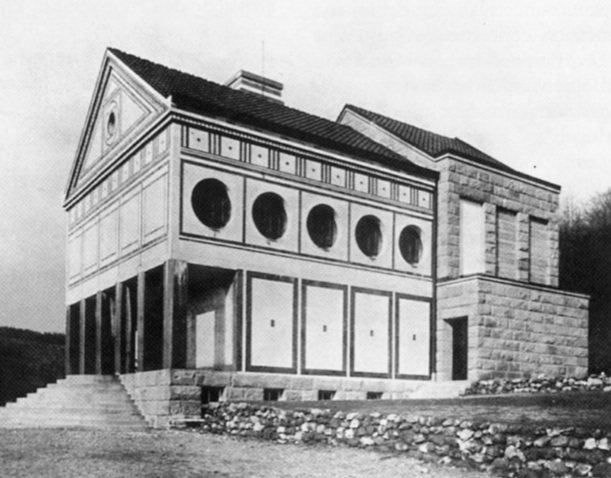
1 | Behrens, Hagen, Crematorium, 1905-08.
Mies also commented on the Düsseldorf period:
About the time of the Oldenburg Exhibition pavilions (1904-05), a man came to Behrens’ office from Berlage. He was interested in geometrical proportioning and arrangements [Mies is obviously also referring to Lauweriks]. Behrens took it up too, as witness Oldenburg. I asked if Behrens had been interested in Early Renaissance work in Italy. Mies said Behrens had always been interested in Italy, and especially in the Early Christian period. Mies cited the Music Hall of the Folkwang Museum in Hagen and the octagonal buildings by Behrens. Mies agreed with my perhaps inadequate observation that Behrens’ geometric play was strictly geometric and without a theoretical basis.
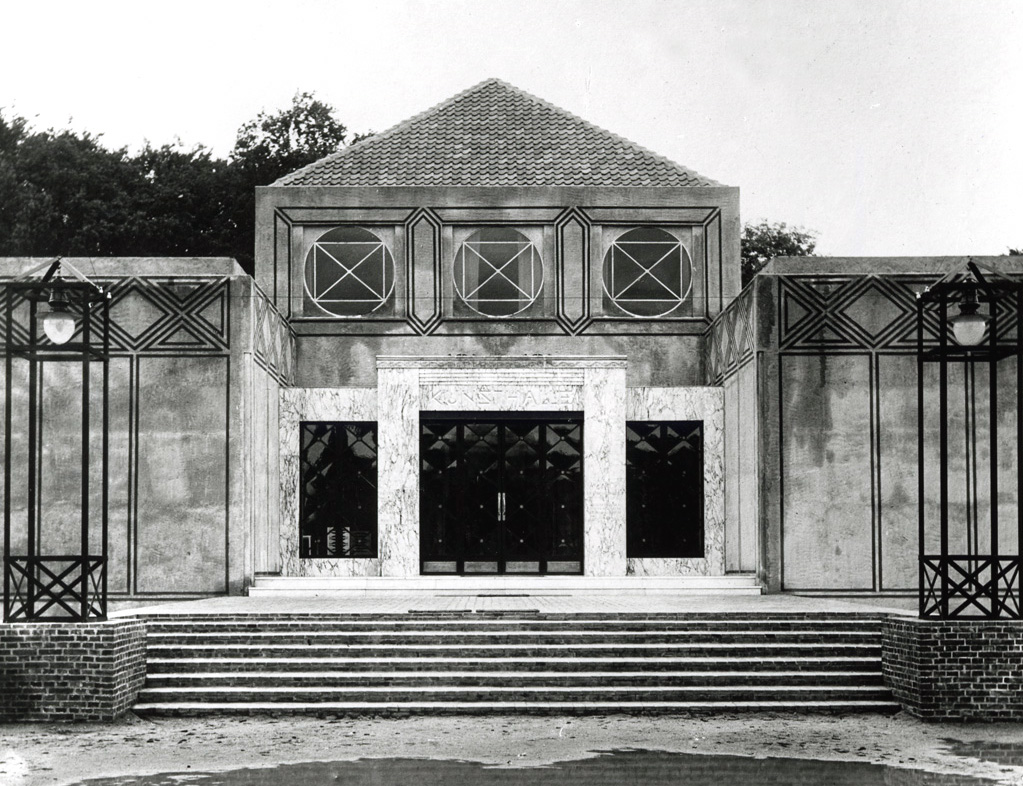
2 | Behrens, Oldenburg, Northwest German Art Exhibition, Kunsthalle and pavilions, 1904-05.
Speaking of octagonal buildings, Gropius was in the Neubabelsberg atelier early enough to have followed the first of Behrens’ works for the AEG, the pavilion for the German Shipbuilding Exhibition in Berlin (1907) – thus we arrive at the Berlin period.
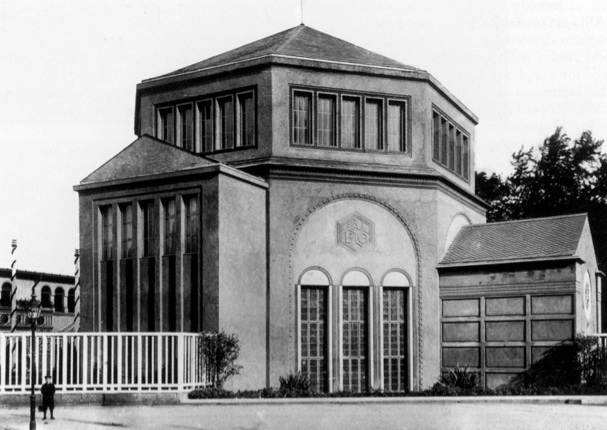
3 | Behrens, Berlin, German Shipbuilding Exhibition, AEG Pavilion, 1907.
In the literature on Behrens, Gropius, and Mies, some issues are reported inconsistently: e.g., the dates of the presence of the two younger men in Behrens’ office and the identification of the projects on which they worked. My interviews do not resolve these matters, but here I summarize views on the chronology [1].
Behrens established himself near Berlin, in Neubabelsberg, in order to assume the unprecedented role of comprehensive designer, in the service of the AEG – graphic designer, industrial designer, architect. Gropius was in the Behrens office from late in 1907 to the middle of 1910. Mies from sometime, perhaps October, of 1908 to the middle of 1910 and again from about May 1911 till very early 1912.
At the time of my interview with Mies, I was beginning to interpret Behrens’ architectural work, not yet engaged by issues of industrial design. A clue offered by Mies now leads me to risk a speculation about Behrens’ form-making. I had asked of Behrens’ interest in the Early Renaissance. Mies accepted this, but emphasized Early Christian work and then carefully noted Etruscan vases as an interest of Behrens.[bucchero vases and Behrens’ arc lamps].
Such a comment not being at the center of my interest at the time, I failed to pursue the matter with Mies and only now have scanned some literature on Etruscan vases. Vases were produced over centuries and in many forms as well as types of ornamentation. It is highly speculative to select any type of Etruscan vase as that which may have interested Behrens. Nonetheless, I do find the bucchero work, and some similar impasto work, of the seventh century BCE so provocative, that I risk simply putting forth a comparison of images — to be explored another day.
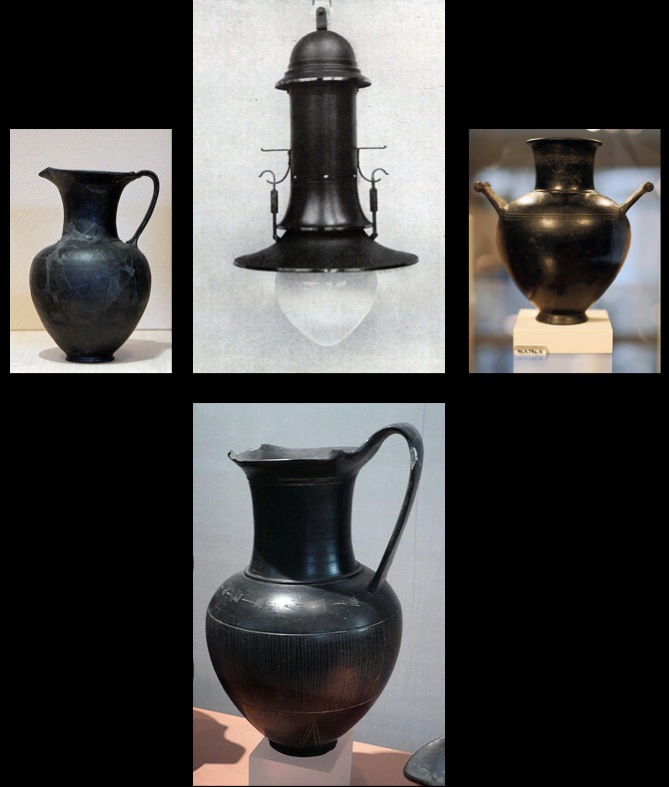
4 | Etruscan vases and an AEG arc-lamp by Behrens, 1907.
Returning to Behrens’ atelier, Gropius and Mies were there in the time of the design and realization of Behrens’ canonic AEG Turbine Factory (1908-09) and for the initial work on the large AEG factory complex on the Humboldthain. However, as Gropius entered the office in 1907, the established commissions were two houses in Hagen stemming from Behrens’ Düsseldorf period. From 1906, Behrens developed for Osthaus the site plan for a group of villas in Hohenhagen, near the site of Osthaus’ own villa by van de Velde. Now two Behrens houses, the Cuno and the Schroeder were in design, and in construction that was to last until 1911 and 1909 respectively. Gropius was reticent to specify what work he did in Behrens’ office, but he was specific that his first project was the Cuno house, and later the Schroeder house, that also engaged Mies. Mies said that he worked on the interiors of both houses.
The two principal AEG factories that fall within Gropius’s time in the office are the Turbine Factory and the High Voltage Factory (1909-10). Gropius’ reticence to claim involvement other than the Hagen villas leaves one to take him at his word: that “Behrens was the man in charge and he had to make the final decisions”.
Mies did say he worked on the AEG Small Motors Factory (1910-13) and the Assembly Hall for Large Machines (1911-12), involvement that could have fallen in either or both of Mies’ periods in the Behrens atelier. I failed to pursue these claims, but I see no reason to seek to dilute Behrens’ achievement in these works, to divide responsibilities between Behrens and Mies. It was specifically in this context that I asked Mies “if Behrens was a hard master or if men like he and Gropius were able to make original contributions?” Mies responded: “No. In those days no one thought of this business of self-expression. Behrens had very definite ideas and his workers learned them. We were more Behrens-like than Behrens himself”.
Mies and Gropius being “more Behrens-like than Behrens”, implies that they were given responsibility and probably also initiative in design projects, but such contributions were in an established context under the control of Behrens.
There are claims for Mies’ direct design contributions in Behrens’ AEG Turbine Factory, stemming from a later report that Mies, in the 1920s, “proudly recounted that he had contributed to the window design on the long western side of the Turbine Factory”.[2]
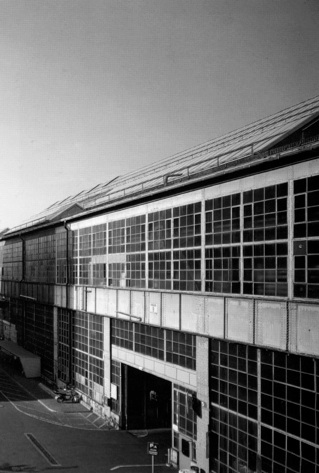
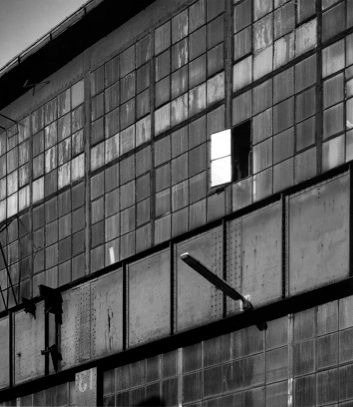
5 | Behrens [with Karl Bernhard], Berlin, AEG Turbine Factory, west elevation, 1908-09.
Two scholars, Tilmann Buddensieg and Mechthild Heuser, elevated this report to claim the west façade as an early work of Mies (Buderath 1990). I am disinclined to accept this attribution for two reasons. In my interview with Mies, he did not include the Turbine Factory among the AEG works with which he was involved. Still more conclusive, the engineer for the Turbine Factory, Karl Bernhard, in his publication on the Factory, stated, with appreciation, that he was given a free hand in the design of this elevation (Bernhard 1911). The façade has a direct elemental quality, logically related to the heavier loading and structure of the ground floor as opposed to the upper floor, yielding what might well be a rational engineering design by Bernhard.
In my dissertation, I contemplated that Mies may have been involved in the design and detailing of two of Behrens’ works: the Mannesmann Administration Building in Düsseldorf and the Gas Works in Frankfurt-Osthafen (both 1910-12). The several buildings and towers of the Gas Works are in a hard engineering brick, impressively precise in itself, and then detailed with crisp arrises and negative reveals. Related forms of detailing, now in stone, are to be found in the Mannesmann building. According to a letter of 12 December 1962 from Henry-Russell Hitchcock, Paul Schneider-Esleben claimed that Mies detailed the Mannesmann entry hall and stair.
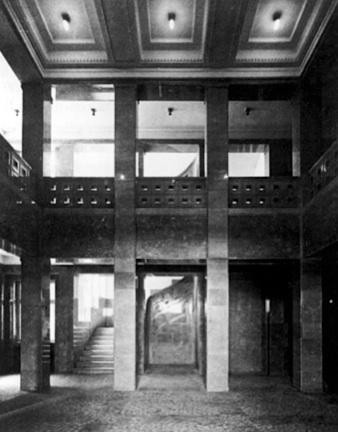
6 | Behrens, Düsseldorf, Entrance hall, Mannesmann Administration Building, 1910-12.
Schneider-Esleben, architect of the 1951-56 glass tower supplementing the Mannesmann building, knew Behrens’ original building well and would be a discerning observer. Heinrich Klotz tells the story, presumably conveyed by Schneider-Esleben, of the visit of Mies to the Mannesmann tower in 1956. Beyond some dissatisfaction with the tower, Mies spoke energetically of the marble hall that he had drawn when in Behrens’ office.[3]
I would still emphasize that several works of Karl Friedrich Schinkel, whom Behrens so deeply revered, provide ample precedent for the selection of brick and its robust detailing as found at the Gas Works. I did ask Mies if he worked on this project. He said “No” and suggested Adolf Meyer. Chronologically, it is just possible that Meyer had some involvement with the Gas Works before leaving Behrens’ office with Gropius, but it seems unlikely that definitive detailing had been established at that time. For the Gas Works, I suggest one best leave this as the work of Peter Behrens under the impact of Schinkel.
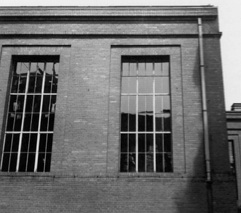
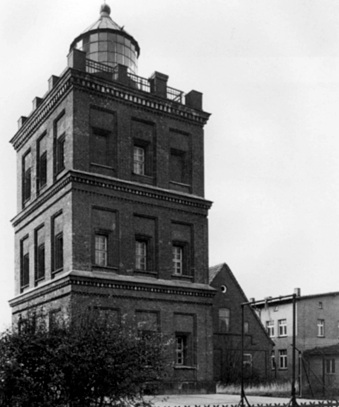
7 | Behrens, Frankfurt-Osthafen, rankfurter Gas Works, 1910-12.
8 | Karl Friedrich Schinkel, Rügen Island, Cape Arkona, Lighthouse, 1825-27.
It is tempting to continue to associate Mies with the refined, interior stone detailing of the hall of the Mannesmann building, detailing of a kind that persisted into modern architecture. Schneider-Eslebens’ testimony supports Mies’ involvement in the design itself. In 1961, the Mannesmann building was one of the few works of Behrens that Mies still knew to exist, along with the Darmstadt house, and the Hagen houses and crematorium. Mies did not, however, include the Mannesmann building among the Behrens works on which he had been involved. Perhaps it is appropriate to continue to accept a certain affinity of Behrens and Mies for design such as that of the Mannesmann hall, while accepting the absence of a claim of involvement by Mies in a work that he had in mind during the interview.
It can still be read that Mies, upon his return to Behrens’ employ in 1911 was sent to St. Petersburg to be the field supervisor of the Imperial German Embassy (1911-13).[4]
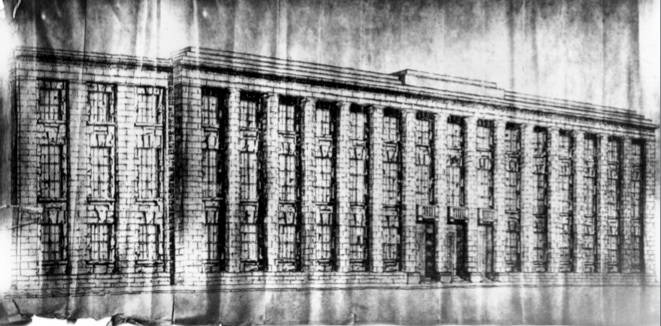
9 | Behrens, St. Petersburg, Imperial German Embassy, 1911-13.
I don’t recall where I had obtained this impression in 1961, but I cited it in opening discussion of that work with Mies. Mies said “No” that he was in charge of the Embassy in the Behrens atelier, not in the field. Particularly at this time it makes sense that he would have been in the office and with such responsibility. This must have been the busiest moment Behrens’ office ever engaged. The AEG Small Motors Factory was in construction; the Gas Works and the Mannesmann building were in advanced design; the Kröller-Müller villa project, the Wiegand House, the Continental Administration Building in Hannover, and the AEG Large Machine Assembly Hall were entering, or about to enter, design – not to mention numerous lesser commissions.
We do not have a precise date for either the re-entry of Mies in Behrens’ office (first half of 1911) or the beginning of design on the Embassy (placed in early 1911). Mies stated that the Embassy had been designed during his absence from the office, and then turned to interesting anecdotes about his involvement with Behrens on the project and the increasing acrimony between them.[5]
Behrens had gone to St. Petersburg to receive the bids. The few German Russian contractors knew that one of them would get the job, so they made the prices high. Behrens came back, and he and Mies went to see ‘a man in government’ about getting enough extra money to build the Embassy. [We know from a later recollection of Edmund Schuler that he was the member of the Foreign Office who in 1911 had convinced first his direct superiors and then the secretary of state Alfred von Kiderlen-Wächter to commission Behrens for the Embassy (SCHULER 1940)].The “man” would hear nothing of it. He had gone to the Reichstag for money to introduce the project. He had gone back for more at another stage [perhaps a Behrens estimate?]. He would not go again. Behrens argued that it would not be built. Mies suggested that he would go to St. Petersburg, work with the bidders and bring the price in range. This angered Behrens, who said: ‘What do you think I was doing there – just smoking cigarettes?’ But the government man liked the idea and Mies was sent.
In St. Petersburg Mies selected the contractor he thought would do the best job and “dickered” with him. He got the price down and returned to Berlin. Behrens was furious; he didn’t like this. I asked if there had been changes in the design that led to this anger? Mies said no, it was just that Behrens didn’t like the idea.
On the job there had been great pressure for a beginning of work, since in St. Petersburg October 28 marks the beginning of frost and no more exterior work. Mies returned to St. Petersburg ‘to receive the building from the contractor.’ As Mies walked through the building with the contractor or his representative, Mies spoke of what Behrens was planning for the interiors. Mies had noticed a third man with them whom he thought was another member of the staff of the contractor. He turned out to be a journalist. Thus there were newspaper accounts of Behrens’ plans before the authorities had even heard of them. When Mies returned to Berlin, Behrens was more angry than before – so Mies told Behrens he was through.
As I visited Mies, and not knowing of his degree of responsibility in the Embassy, I arrived with a very negative impression of the rudely imposing classicism of the Embassy.
I asked Mies about Behrens severe classicism in the Embassy; was it due to government pressure? No, it was quite willing on Behrens’ part. When he came to Berlin, Behrens was very much struck with Schinkel and other neo-classical architects as evidenced by their works: Altes Museum, Opera, Wache (remodeled by Tessenow into the grave of the unknown soldier), Unter den Linden, the Brandenburg Gate. Even though Behrens could do a modern industrial building or a modern arc-lamp, and even though Behrens was actively concerned with an architectural expression relative to the times — still, no one could conceive how to do this for a ‘representative’ building.
Mies agreed that the Embassy did not show the refinement of Schinkel, but pointed out that the interiors more closely approximated such quality. It is not in my interview notes, but Mies surely had a role in the Embassy interiors: he was in charge of the project in the office, and contemporary demands in the office were so extensive that he must have taken a significant role in the design of the interiors that he was too quick to discuss in St. Petersburg — and note his defense of the interiors. Tilman Buddensieg has built the case both for an appreciation of the Embassy interiors and for Mies’ role there, with particular reference to the entrance vestibule and stair (Buddensieg 1984).
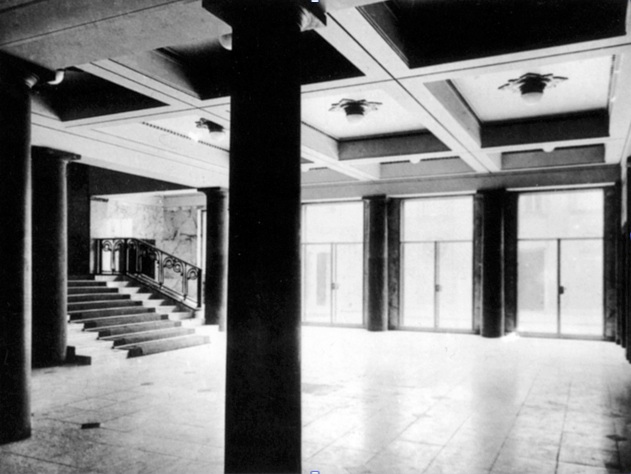
10 | St. Petersburg Embassy, Entrance hall.
Mies’ other acknowledged involvement in the Behrens office in 1911 was in the design for the Kröller-Müller villa near The Hague. They jointly traveled to Holland, and in Amsterdam came upon Berlage’s Exchange Building. Mies: “Behrens said with a wave of the hand, ‘Passé’. I said ‘You might be wrong there’ – which Behrens also didn’t like.”
The Embassy affair led Mies to quit Behrens, and so also his part in the Kröller-Müller project.
Now Mies wrote the Kröllers telling them of his departure from Behrens’ office, the reason, and his wishes for their success in the building project. The Kröllers had held some misgivings about Behrens’ design and now decided to withdraw too. They proposed that Mies and Berlage do a design.
Mies went to Holland. He was shown about by the Kröllers — and soon they wanted to see what he would do on his own. In the end they chose Berlage’s design over Mies’. However, this was not built due to the war.
So much for Mies and Gropius in Behrens’ atelier. Upon leaving Behrens, Gropius so informed Karl Ernst Osthaus, an occasion for commiseration about the long, problematic realization of the Cuno House in Hagen. Gropius’ established relation with Osthaus continued in the activities of Osthaus’ Deutsches Museum für Kunst in Handel und Gewerbe and in their mutual involvement in the Deutscher Werkbund.
Having left Behrens, Gropius and Adolf Meyer were quick to realize a work that retains its significance in the oeuvre of Gropius, the Fagus Factory of 1911. Gropius was rather mischievous in saying he had omitted the corner column in the Faguswerke simply because he liked it that way. Only later did he realize (learn?) that there is a structural logic to this organization of forces. Gropius mentioned this seemingly humbling story:
[...] in a discussion on the importance of intuition and creative feeling. Gropius expressed irritation with historians who have made the Bauhaus into a functionalist organ par excellence — and of functionalism a purely material thing. Functionalism must also recognize the psychic problems.
One can understand Gropius’ frustration with historians. In the U. S., Hitchcock and Johnson conveyed, and succeeded in generalizing, the work of Gropius and Mies, of the so-called International Style, as a style – something categorically opposed to reduction to mere functionalism. Meanwhile European terminology for the same historical phenomena had come to be, and in large part still remains, the “architecture of functionalism.” Aalto, Neutra, and other architects fought against this degeneration, but “functionalism” remained too useful a label whether advanced positively or as a straw-man, as in post-modernism.
Important later encounters of Behrens and Gropius came in the context of the Deutscher Werkbund Exhibition of 1914 in Cologne. In Gropius’ model factory complex at the Exhibition, Gropius made a clever twist on Behrens’ successful strategy for the Turbine Factory.
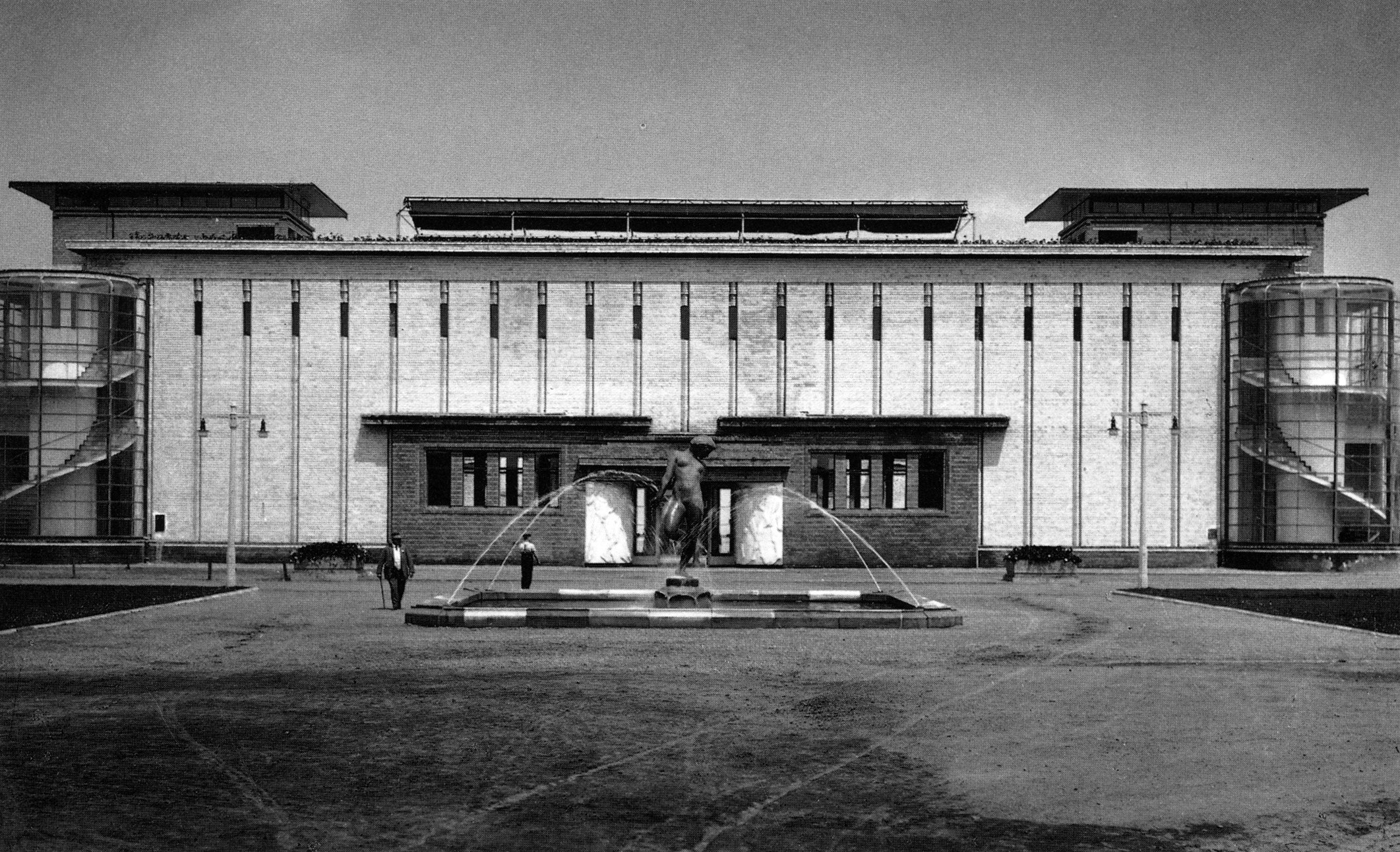
.jpg)
11 | Walter Gropius, Model Factory, Cologne, Deutscher Werkbund Exhibition 1914.
If the AEG’s powerful factory of new energy systems could be analogized to the temple, then why not analogize a more generic factory complex to the organization of an Early Christian church complex such as that of Old St. Peter’s in Rome?
Though Gropius said little about his exceptional work in Cologne, he did mention engaging “the creative engineer [Hans] Schmuckler.” Gropius continued that Schmuckler, in working for Behrens on the Turbine Factory, had probably played a large part in the design of the technical parts of that work. Gropius was wrong in making Schmuckler the engineer of the Turbine Factory, Karl Bernhard’s role is well established. However, it seems likely that Gropius was concerned, and quite rightly, that the engineer of the Turbine Factory should receive an appropriate degree of credit for that work.
We know that Bernhard was also the engineer for the AEG High Voltage Factory. As far as I know, Tilman Buddensieg and his team have not identified the engineer(s) for the AEG Small Motors Factory or for the Large Machine Assembly Hall — nor have I. Could Gropius have misdirected Schmuckler’s contribution from one or both of these factories to the Turbine Factory? Gropius had other, still more interesting observations from the events of the Werkbund Exhibition:
Gropius came to feel almost a hatred for his old master Behrens due to his perception of the low quality of Behrens’ Festival Hall for the Exhibition.
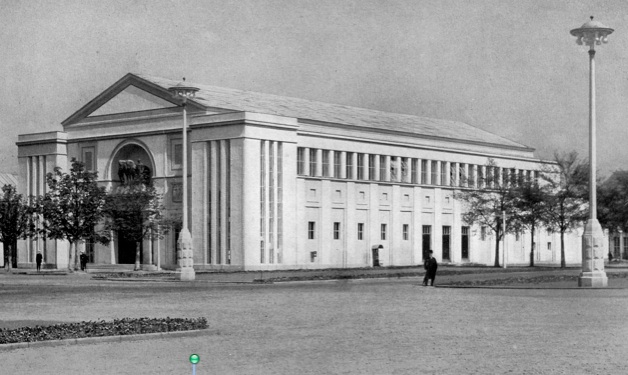
12 | Behrens, Festival Hall, Deutscher Werkbund Exhibition 1914.
[Strong language, but one can indeed understand the Festhalle as a provocation to those who still imagined a new architecture.] Gropius continued, characterizing himself as the enfant terrible of the Exhibition, who nonetheless was made a member of the Board of the Werkbund. When Muthesius made his plea for type and for standardization, he was doing something very negative, and also evidencing his lack of artistic and creative feeling. Gropius went to the Board and revealed a number of black dealings into which Muthesius had entered in seeking to insure his position in the Werkbund. Muthesius was forced to resign. Gropius said this was something that he would not do today, but he was young then. [I observed in my notes that Gropius obviously disliked Muthesius very much.] Gropius ended by noting that he aligned himself with Henry van de Velde in the famous confrontation of the 1914 Werkbund debate.
Some last words about my visit with Mies van der Rohe, an interview occasioned by my then recent committment to a dissertation on Peter Behrens. Mies thoughtfully brought his copy of Fritz Hoeber’s 1913 Behrens monograph to our meeting. More telling, however, was that Mies also brought Jan Gratama’s monograph on Berlage. Mies was concerned to draw my attention to Berlage, reinforced by his stories that placed Berlage in a more favorable light than Behrens. There may have been a gentle persuasion that I should embark on a study of Berlage rather than Behrens. There surely was a clear message of where Mies placed his intellectual and architectural allegiance.
In his otherwise empty office, Mies had placed two other books, though they were not discussed. One was An Outline of Man’s Knowledge of the Modern World, a then current volume, edited by Lyman Bryson, a noted New York academic. It presented insights into current thought in philosophy, science, social sciences, law and the arts, as viewed by notable authors of American liberal convictions. Perhaps this was an indication of Mies’ broader interests. One chapter, “Mathematics, The Language of Science,” is by Mario Salvadori, a highly esteemed New York structural engineer, likely known to Mies (Bryson 1960).
The other book was Theorie des gegenwartigen Zeitalters by Hans Freyer, a noted conservative sociologist at the University of Leipzig (Freyer 1955). His 1931 book, Revolution von rechts (Revolution from the Right), with its inclination to radical conservative, totalitarian solutions to the problems of the liberal state, gave Freyer and his thought prominence in the years just before and after Hitler’s accession to power. Later disillusion with National Socialism led Freyer to attempt a reformulation of conservative thought. Theorie des gegenwartigen Zeitalters was widely read and influential in the Adenauer years. Jerry Z. Muller’s The Other God that Failed: Hans Freyer and the Deradicalization of German Conservatism (Muller 1987)considers Freyer, not for exceptional qualities of the man or his thought, but precisely as someone whose life and thought is representative within his époque — representative for the embrace of a radical conservatism followed by a disillusioned reconstruction of conservative thought. One might wonder if Mies too, found something representative in this curriculum.
Behrens’ personality
Both Gropius and Mies found Behrens to be a hard master. Gropius was quite encompassing in his observations, from Behrens the artist in Munich to “getting mixed up with Expressionism” after World War I. He expressed appreciation for the Hagen Crematorium but was “moved to anger” over the Werkbund Festhalle. Gropius’ account of life in the Behrens atelier:
Behrens underpaid everyone; one never seemed to feel human warmth in dealing with him. He was extremely egocentric and proud. This came out in his dealings with his workers, but he was also very cruel to his wife and children. Gropius was on the side of the wife, but this was apparently around the time when he was thinking of going on his own anyway. Gropius’ proposals of how he might continue to grow in the company of Behrens were not reciprocated. So Gropius withdrew, taking Adolf Meyer with him. [Jean] Krämer had been another right hand man in the office — he could design quite well too — but generally he did as Behrens, or even Gropius, told him. Gropius did not know what had become of Krämer [note that this is another indication that Mies and Gropius had some design initiative].
Mies gave other specifics about his experience in the atelier, such as Behrens’ assertiveness, having possessed no real, close friends, recognizing no particular qualities in his assistants — “not a warm man.” Despite these negative assessments of Behrens the person, Mies observed: “I learned a lot from him.” Gropius was still more appreciative. In going to Behrens in 1907:
Gropius was anxious to ‘get some solid ground under himself;’ he worked hard and long for Behrens and was grateful to be doing and learning. Gropius considered Behrens his chief master. It was Behrens who taught him to think in principles.
About this last, I observed in my notes: “From the context it was clear that “thinking in principles” meant for Gropius that, whereas the schools taught styles, Behrens tried to understand the principles behind the styles – and to reapply them again. Gropius meant at least this; he may have meant more too.”
Notes
[1] From the Gropius interview: Following his architecture studies in Munich and Berlin, Gropius received an inheritance of 1000 Marks. His father encouraged him to do as he wished with the inheritance. Gropius wanted to find himself by entering a completely different environment. He chose to go to Spain. There he met Karl Ernst Osthaus, the industrialist and art collector from Hagen, who had been the patron of Behrens, Henry van de Velde, Lauweriks and others. It was Osthaus who convinced Gropius to go to Behrens for work. (Nerdinger 1985) puts dates to this: travel in Spain from late 1906 and arrival in Behrens’ atelier in Neubabelsberg in late 1907]. From the Mies interview: Mies had been working in the office of Bruno Paul, the director of the Kunstgewerbeschule in Berlin. Paul Thiersch, whom Mies credited as a “good architect”, had been in Behrens’ atelier, but now came over to Paul’s office. It was Thiersch who told Mies that Behrens was looking for men and that he should go see Behrens, who did give him a job. [(Schulzer 1985) puts Mies’ arrival in Behrens’ atelier in October 1908. According to Wolf Tegethoff, in (Riley, Bergdoll 2001), Mies was first in Behrens’ office “sometime in 2008”]. I asked Mies if the house that he built in Neubabelsberg a year earlier, the Riehl house, had been a factor in his employment by Behrens. Mies said “No”. Mies spoke of two periods of work in Behrens’ atelier. [Various sources report differently on the time that Mies was away from the atelier. It does seem to have been for about one year, extending from either early or mid-1910]. Gropius spoke of a planned trip to Greece with Behrens, they even had tickets, but at the last minute a critical job came up and the plan collapsed. Gropius did travel to England with Behrens; there had been the possibility of a job that did not materialize. Gropius: “We went around, looked at the museums, saw the city”. [Tegethoff (137, n. p. 377) says Gropius left Behrens’ office in March, 1910; Schulze gives June 1910. (Giedion 1954) cites Mies recalling a birthday party for Gropius by the members of the Behrens office on May 18, 1910. We may then conclude that both of the younger men had left Behrens’ office by the middle of 1910.] Gropius was specific in saying that the young Le Corbusier came to Behrens after his departure. [It now seems settled that Jeanneret’s time with Behrens was from November 1910 to April 1911. Apparently, Mies would also not have been a co-worker with Jeanneret, as Mies’ second period with Behrens began in May or June 1911 (Tegethoff). Mies himself is cited to that effect. However, if a contemporary document from the Kröller-Müller affair, cited by (Schulze 1985) (p. 41) is reliable, Mies and Jeanneret may have been jointly present for a brief time in the spring of 1911].
[2] Personal communication of Sergius Ruegenberg.
[3] Heinrich Klotz, “Einführung”, in (Klotz 1987). The anecdote continues with Le Corbusier [Jeanneret] simultaneously drafting one façade variation after another for Behrens’ Mannesmann building, and Gropius drawing the plans. See n. 2 for the problematic chronology for such a claim.
[4] Tegethoff in Mies in Berlin, 137.
[5] Parts of these stories appeared in my dissertation and such accounts are also in (Schulze 1985), 57-58, though his source is not revealed. All the events discussed by Mies would have been in 1911 and perhaps into January 1912.
References
- Anderson 2000
S. Anderson, Peter Behrens and a New Architecture for the Twentieth Century (Cambridge, MA: The MIT Press, 2000); in Italian as Peter Behrens: 1868-1940 (Milan: Electa, 2002), with more numerous images in better reproduction. The Ph.D. dissertation was for Columbia University, New York City, 1968. - Bernhard 1911
K. Bernhard, “Die neue Halle für Turbinenfabrik der Allgemeinen Elektricitäts-Gesellschaft in Berlin”, in “Zeitschrift des Vereines deutscher Ingenieure” 55 (30 Sept. 1911), 1625-31, and (7 Oct. 1911), 1673-82. - Bryson 1960
L. Bryson, ed., An Outline of Man’s Knowledge of the Modern World (New York: McGraw-Hill, 1960). - Buddensieg 1984
T. Buddensieg, “Die Kaiserlich Deutsche Botschaft in Petersburg von Peter Behrens”, in M. Warnke, ed., Politische Architektur in Europa vom Mittelalter bis heute — Repräsentation und Gemeinschaft (Cologne: DuMont, 1984), 374-398. - Buderath 1990
B. Buderath, ed., Peter Behrens: Umbautes Licht (Munich: Prestel, 1990), 67 Mechthild Heuser in H-G. Pfeifer, ed., Peter Behrens: “Wer aber will sagen, was Schönheit sei?” (Düsseldorf: Beton-Verlag, 1990), 115-16. - Freyer 1955
H. Freyer, Theorie des gegenwartigen Zeitalters (Stuttgart: Deutsche Verlags-Anstalt, 1955). - Giedion 1954
S. Giedion, Walter Gropius: Work and Teamwork (New York: Reinhold, 1954), 17. - Klotz 1987
H. Klotz, ed., Paul Schneider-Esleben: Entwürfe und Bauten 1949-1987 (Braunschweig/Wiesbaden: Vieweg, 1987), 13. - Muller 1987
J.Z. Muller, The Other God that Failed: Hans Freyer and the Deradicalization of German Conservatism (Princeton University Press, 1987). - Nerdinger 1985
W. Nerdinger, Walter Gropius (Berlin: Gebr. Mann, 1985), 38. - Neumeyer 1991
F. Neumeyer, The Artless World: Mies van der Rohe on the Building Art (Cambridge, MA: The MIT Press, 1991), 354, n. 40. - Riley, Bergdoll 2001
T. Riley, B. Bergdoll, Mies in Berlin (New York: Museum of Modern Art, 2001), 137. - Schuler 1940
E. Schuler, “Peter Behrens”, in “Die Kunst im Deutschen Reich” (Ausgabe B: Die Baukunst) 4 (April 1940), 65-6. - Schulze 1985
F. Schulze, Mies van der Rohe: A Critical Biography (Chicago: University of Chicago Press, 1985), 38.
Abstract
The aim of this essay is to reconstruct the profile and atelier of Peter Behrens. The author, a young scholar, had the opportunity to interview both Ludwig Mies van der Rohe and Walter Gropius about their experiences in Peter Behrens' atelier in Berlin. In June 1961, Mies van der Rohe met the author of this essay for an interview in his office at 230 East Ohio Street in Chicago. Later, Walter Gropius also met him for a two-hour lunch on 6 February 1964 at his favourite restaurant in Harvard Square in Cambridge, Massachusetts. The interviews were not recorded, but he manages to report the account of the discussions. Information from these interviews appeared in his doctoral thesis of 1968, published much later as Peter Behrens and a New Architecture for the Twentieth Century (Anderson 2000). In this essay, the author illustrates parts of his notes, where they best convey the thinking of Mies or Gropius. Both offered insights into Behrens' career before the moment they converged in Berlin (1907-2008).
keywords | Peter Behrens; interviews; Mies van der Rohe; Walter Gropius.
To cite this article: S. Anderson, Considering Peter Behrens. Interviews with Ludwig Mies van der Rohe (Chicago, 1961) and Walter Gropius (Cambridge, MA, 1964), “La Rivista di Engramma” n. 81, giugno 2010, pp. 9-27 | PDF dell’articolo